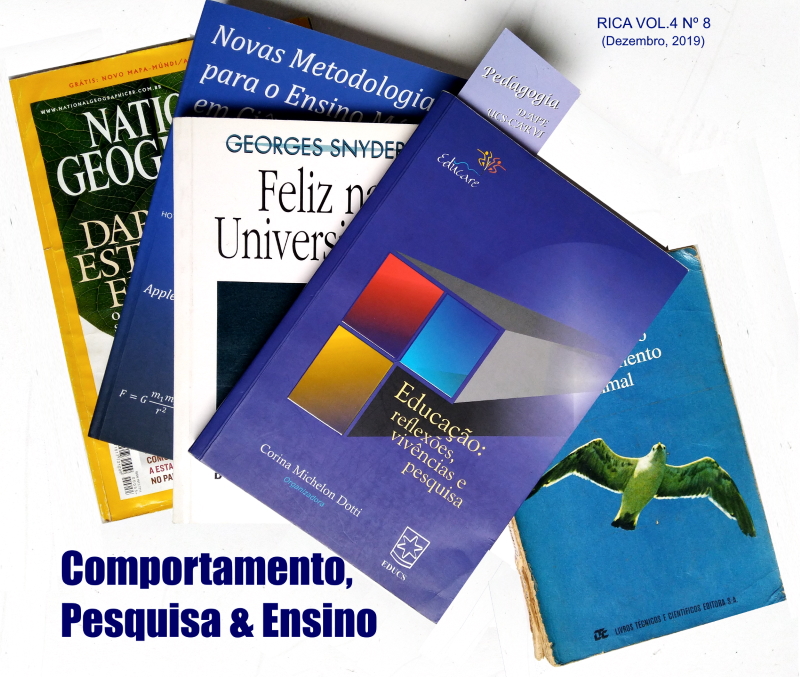Behavioral study of Eira barbara (Carnivora: Mustelidae) in captivity conditions
Keywords:
ethology, behavior, captivity, tayraAbstract
When a wild animal is kept under human care, their actions and choices can be limited, this way, their welfare could be compromised, thus causing the appearance of stereotyped behaviors. The objective of this study was to evaluate the behavior of an individual of Eira barbara (Carnivora: Mustelidae) under captive conditions and verify the possible presence of stereotyped behaviors. The data was collected in the Projeto Lontra, linked to Instituto Ekko Brasil, Florianópolis - SC. The observations were divided into two stages: preliminary and data collection. In the preliminary stage, all data were collected through the Ad Libitum method for three days, resulting in 7 hours per day. In the stage of data collection, the sampling was done through the "Focal animal" method and lasted five days. Four daily observation sessions of 30 minutes each were performed. In the preliminary stage, 31 different behaviors were observed, divided into seven categories: Food, Activity, Stereotype, Inactivity, Locomotion, Maintenance and Marking. A total of 600 behavioral records were obtained in the data collection step. The most present behaviors were “Pacing” with 37% of frequency and “Lying down” with 24%. These data, together with the low frequency of Activity (16%), indicate a compromise of well-being. This study revealed that stereotyped behavior is present in this tayra. Thus, it is fundamental for an environmental enrichment plan to be established as an alternative to improve the captive conditions of the animal and thus reduce the occurrence of these behaviors.
References
PITSKO, L.E. Wild tigers in captivity: a study of the effects of the captive environment on tiger behavior. 2003. 64 p. Dissertação de mestrado - Virginia Polytechnic Institute and State University, 2003.
CASTRO, L.S.D. Influências do enriquecimento ambiental no comportamento e nível de cortisol em felídeos silvestres. 2009. 110 p. Dissertação (Mestrado) Universidade de Brasília - UnB, 2009.
SALAS, M.; MANTECA, X. 2016. Assessing welfare in zoo animals: animal-based indicators. Zoo Animal Welfare Education Centre, 4, 2016.
FACCIO, L.; ZANETTE, R.A.; SALOMÃO, E.L.; MONTEIRO, S.G. Registro de protozoários gastrintestinais em irara (Eira barbara) mantida em cativeiro no Brasil. Revista Brasileira de Zoociências, 10, p. 83-85, 2008.
PRESLEY, S.J. 2000. Eira barbara. Mammalian Species, 636, p. 1–6.
REIS, N.R.; PERACCHI, A.L.; PEDRO, W.A.; LIMA, I.P. 2006. Mamíferos do Brasil. Londrina, Neilo R. dos Reis, 439p.
DELGADO-V, C.A.; ÁRIAS-ALZATE, A.; BOTERO, S.; SÁNCHEZ-LONDOÑO, J.D. Behaviour of the Tayra (Eira barbara) near Medellín, Colombia: preliminary data from a video-capturing survey 3. Small Carnivore Conservation, 44, p. 19-21, 2011.
ENCKE, W. A note on the breeding and rearing of tayras Eira barbara at Krefeld Zoo. International Zoo Yearbook, 8, p. 132, 1968.
SILVA, R.O. Enriquecimento ambiental cognitivo e sensorial para onças-pintadas (Panthera onca) sedentárias em cativeiro induzindo redução de níveis de cortisol promovendo bem-estar. 2011. 71 p. Dissertação (Programa de Pós-Graduação em Ciências do Comportamento - Mestrado) - Universidade de Brasília - UnB, 2011.
BROOM, D.M. Bem-estar animal. In: YAMAMOTO, M.E; VOLPATO, G.L. Comportamento Animal. Natal. Editora da Universidade/UFRN, 2011. p. 457-482.
LIPINSKI, G.P. Associação de enriquecimento ambiental e design de recintos com o bem-estar dos animais do zoológico municipal de canoas. 2014. 28 p. Universidade Federal do Rio Grande do Sul - UFRGS, 2014.
MELLOR, D. Operational details of the five domains model and its key applications to the assessment and management of animal welfare. Animals, 7, 60, 20 p., 2017.
COUTINHO, P.H.M. Enriquecimento alimentar e cognitivo para o bem-estar em cativeiro. 2012. 80 p. Dissertação (Programa de Pós-Graduação em Teoria e Pesquisa do Comportamento - Mestrado) - Universidade Federal do Pará - UFPA, 2012.
FERRARI, R.C.L. Estudo do comportamento de Lontra longicaudis (olfer 1818) cativo, mediante estímulos de enriquecimento ambiental. Revista Ceciliana, 4, p. 40-43, 2011.
BORGES, M.P. Influência de técnicas de enriquecimento ambiental no aumento do bem-estar de Callithrix penicillata (E. Geoffroy, 1812) (Primates: Callitrichidae). Revista Biotemas, 24, p. 83-94, 2011.
SUSANA, T. 2016. Manual de enriquecimento ambiental. São Paulo. 13 p.
ADAMS, K.M. Refinement in the literature: Searching for environmental enrichment. Japanese Society for Alternatives to Animal Experiments, 14, p. 307-312, 2008.
CAMPOS, M.B.D.T.A.D. Efeito do cativeiro e enriquecimento ambiental sobre diversas manifestações comportamentais de uma colónia de chimpanzés. 2017. 132 p. Dissertação (Mestrado) - Universidade de Lisboa - ULISBOA, 2017.
MANACERO, R.B.; TANDELLO, A.D.M.; NOGALLI, O. Enriquecimento ambiental como ferramenta de tratamento para redução de comportamento estereotipado de macacocaiarara (Cebus kaapori). Atas de Saúde Ambiental, 2, p. 47-53, 2014.
BLOOMSMITH, M.A.; BRENT, L.Y.; SCHAPIRO, S.J. Guidelines for developing and managing an environmental enrichment program for nonhuman primates. American association for laboratory animal science. 41, p. 1-6, 1991.
OLIVEIRA, M.F. Etograma de mico-leão-preto (Leontopithecus chrysopygus Mikan, 1823) em cativeiro, com ênfase no comportamento reprodutivo. 2016. 106 p. Dissertação (Programa de Pós-Graduação em Conservação da Fauna - Mestrado) - Universidade Federal de São Carlos - UFSCar, 2016.
DEL-CLARO, K. 2004. Comportamento Animal: Uma introdução à ecologia comportamental. Jundiaí: Livraria Conceito. 120 p.
SOUTO, A.S. Etologia: princípios e reflexões. 3.ed. Recife: Editora Universitária da UFPE. p. 46-50, 2005.
PEREIRA, R.L.A.; OLIVEIRA, M.A.B. Etograma do Eira barbara (Carnivora: Mustelidae) em cativeiro. Revista de etologia, São Paulo, v. 9, n. 1, p. 45-57, 2010.
CLUBB, R.; MASON, G. Animal Welfare: Captivity effects on wide-ranging carnivores. Nature, 425, p. 473–474, 2003.
LESSA, M.A.M. Bem-estar em cativeiro: análise e planejamento da ocupação do tempo em macaco-prego (Cebus apela). 2009. Dissertação (Programa de pósgraduação em Teoria e Pesquisa do Comportamento - Mestrado) - Universidade Federal do Pará - UFPA. 2009.
NELSON, K.O. Environmental enrichment effects on the activity of a Nearctic river otter. 2009. 95 p. Dissertação (Mestrado) - Rochester Institute of Technology, 2009.
BASHAW, M.J. et al. A survey of variables related to stereotypy in captive giraffe and okapi. Applied animal behavior science, v. 73. N. 3, p. 235-247. 2001.
RODRIGUES, L. S. F. et al. Comportamento e distribuição de um grupo de macaco-prego (Cebus apela Linnaeus, 1758) mantido em cativeiro. CES Revista, Juiz de Fora, v. 24, 2010.
ALMEIDA, A. M. R; MARGARIDO, T. C. C; FILHO, E. L. A. Influência do enriquecimento ambiental no comportamento de primatas do gênero Ateles em cativeiro. Arquivos de Ciências Veterinárias e Zoologia da UNIPAR, Umuarama, v. 11, n. 2, p. 97-102, jul/dez. 2008.
VICKERY, S.S.; MASON, G.J. Stereotypic behavior in Asiatic black and Malayan sun bear. Zoo Biology. 23, p. 409-430, 2004.
CARLSTEAD, K.; SEIDENSTICKER, J. Seasonal variation in stereotypic pacing in an American black bear (Ursus americanus). Behavioural Processes, v. 25, n. 2-3, p. 155-161. 1991.
CORAT, C.S. Implantação de um programa de enriquecimento ambiental para cachorro-vinagre (Speothos venaticus) na Fundação parque Zoológico de São Paulo. 2009. 78 p. Dissertação (Bacharel em Ciências Biológicas) - Universidade Federal de Santa Catarina - UFSC. 2009.
Downloads
Published
How to Cite
Issue
Section
License
Copyright (c) 2021 Interdisciplinary Journal of Applied Science

This work is licensed under a Creative Commons Attribution-NonCommercial-NoDerivatives 4.0 International License.
Authors keep the copyright and cede to the journal the right of publishing first. Published works are licensed under a Creative Commons Attribution 4.0 International (CC BY 4.0) license, allowing the sharing of the work with recognition of the authorship and initial publication in this journal.






